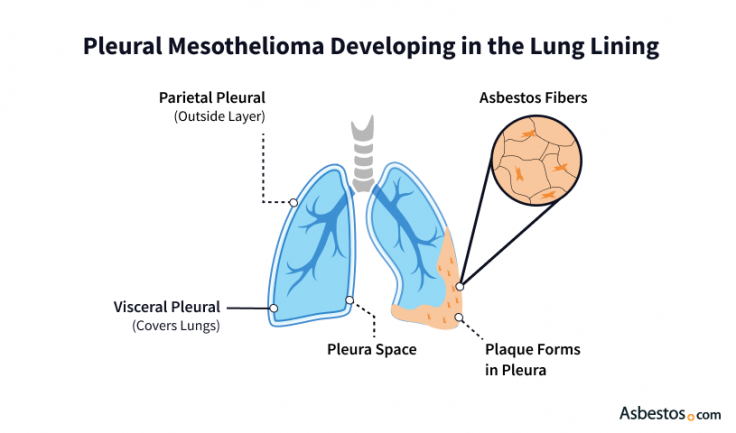Pleural Mesothelioma
Pleural mesothelioma is a cancer of the pleura, or lining of the lungs. Inhaling asbestos fibers is the main cause. Malignant pleural mesothelioma accounts for more than 70% of mesothelioma cases. Symptoms include shortness of breath, cough and chest pain.
Written byKaren Selby, RN•Edited ByWalter Pacheco•Medically Reviewed ByDr. Jacques Fontaine
Asbestos.com is the nation’smost trustedmesothelioma resource
The Mesothelioma Center at Asbestos.com has provided patients and their loved ones the most updated and reliable information on mesothelioma and asbestos exposure since 2006.
我们的团队的病人倡导者包括医疗doctor, a registered nurse, health services administrators, veterans, VA-accredited Claims Agents, an oncology patient navigator and hospice care expert. Their combined expertise means we help any mesothelioma patient or loved one through every step of their cancer journey.
More than 30 contributors, including mesothelioma doctors, survivors, health care professionals and other experts, have peer-reviewed our website and written unique research-driven articles to ensure you get the highest-quality medical and health information.
About The Mesothelioma Center at Asbestos.com
- Assisting mesothelioma patients and their loved ones since 2006.
- Helps more than 50% of mesothelioma patients diagnosed annually in the U.S.
- A+ rating from the Better Business Bureau.
- 5-star reviewed mesothelioma and support organization.
Testimonials
My family has only the highest compliment for the assistance and support that we received from The Mesothelioma Center. This is a staff of compassionate and knowledgeable individuals who respect what your family is experiencing and who go the extra mile to make an unfortunate diagnosis less stressful. Information and assistance were provided by The Mesothelioma Center at no cost to our family.LashawnMesothelioma patient’s daughter
How to Cite Asbestos.com’s Article
APA
Selby, K. (2023, September 28).Pleural Mesothelioma.Asbestos.com. Retrieved September 28, 2023, from //www.magnakarsa.com/mesothelioma/pleural/
MLA
Selby, Karen. "Pleural Mesothelioma."Asbestos.com, 28 Sep 2023, //www.magnakarsa.com/mesothelioma/pleural/.
Chicago
Selby, Karen. "Pleural Mesothelioma." Asbestos.com. Last modified September 28, 2023. //www.magnakarsa.com/mesothelioma/pleural/.
What Is Pleural Mesothelioma?
Pleural mesothelioma is a rare cancer that develops within the pleura, the protective lining encasing the lungs and chest walls. Asbestos exposure is the main cause of mesothelioma.

Pleural mesothelioma is the most commontype of mesothelioma cancer, accounting for 70% to 79% of cases. Each year, doctors diagnose more than 3,000 new patients with mesothelioma in the United States.
Symptoms
The most common symptoms of pleural mesothelioma include difficulty breathing, swelling, back pain, and nerve pain. For many people,mesothelioma symptomsare not noticeable until the last stage.
List of the most common symptoms:
- Shortness of breath
- Chest pain or painful breathing
- Persistent dry or raspy cough
- Coughing up blood
- Difficulty swallowing
- Pain in the lower back or rib area
- Unexplained weight loss and fatigue
- Swelling of the face or arms
- Night sweats or fever
- Lumps under the skin on the chest
- Fluid in the lungs
患者很少提到杜减肥和疲劳ring their initial doctor visits. These symptoms may only appear in advanced disease.
Malignant pleural symptoms may reveal a person’s history of asbestos exposure. Research shows that early signs include pleural plaques, effusions and thickening.
Pleural Plaques
Pleural plaques are small areas of thickening on the pleura. These are the most common sign someone has a history of asbestos exposure.Pleural plaquesare not cancerous. They usually do not cause symptoms but may exhibit an elevated cancer risk.
Pleural Effusion
Airway irritation can cause excess fluid in the chest. This is known as a pleural effusion. The fluid builds up between the two layers of the pleura. A little fluid between the pleural layers is healthy. Too much puts pressure on the lungs, causing chest pain that worsens when you cough or take deep breaths.
Pleural Thickening
Scarring causes large areas of the pleura to become thicker and stiff. Breathing may become difficult and painful.Pleural thickeningaround both lungs is often a sign of significant asbestos exposure. Repeated pleural effusions can worsen pleural thickening as scar tissue develops.
Asbestosis
Asbestosis is a progressive scarring of lung tissue caused by asbestos. Patients with asbestosis have a high risk of developing asbestos-related lung cancer. This condition does not affect the pleural lining.

Causes
The primarycause of pleural mesotheliomaisasbestos exposure.当有人吸入石棉os, the microscopic fibers become lodged in the pleura and cause irritation.
The sharp and pointed asbestos fibers are like needles that become stuck in the lungs. Over time, asbestos fibers migrate to the pleural lining. The constant irritation causes scar tissue and DNA mutations which lead to cancer.
Who Is Most At Risk?
People at risk of pleural mesothelioma most often include blue-collar workers and veterans. Occupational asbestos exposure is the No. 1 cause of the disease, and several occupations pose a high risk factor.
This cancer usually takes 20 to 60 years to develop after a person’s first exposure to asbestos. Most people receive a diagnosis after age 70 because of the long latency period.
- Military Veterans:The U.S. military used asbestos widely in machinery and construction materials. Veterans in shipyards were among the most heavily exposed.
- Firefighters:In addition to exposure to asbestos in burning buildings, firefighting equipment, including ventilators and masks, were made with asbestos.
- Construction Workers:No industry used asbestos more than the construction industry. As a result, construction workers are among occupations most at risk of pleural mesothelioma.
- Power Plant Workers:Asbestos was used in arch chutes, electrical insulation, electrical panels and more, exposing many power plant workers throughout the U.S.
- Industrial Workers:Those who worked at industrial worksites and applied industrial insulation were heavily exposed to asbestos.
Workers in the past would carry asbestos fibers home on their clothing and tools after exposure to various types of asbestos products and building materials. This oversight led to secondary exposure among their loved ones.
Environmental exposure is a less common exposure pathway but can affect entire communities. The town of Libby, Montana, spent years removing asbestos contamination. The source was an asbestos-contaminated vermiculite mining operation.

Diagnosis
Thediagnostic process for pleural mesotheliomabegins with symptoms and testing. Doctors order a chest X-ray for chest pain and breathing difficulty. This test can reveal fluid buildup or tumors around a lung.
A primary care physician then refers a patient to a specialist for further testing. A biopsy is necessary to diagnose this disease because it is the only test that detects cancerous tissue in areas such as the lungs or chest wall.
- Physical Examination:在体检医生for abnormalities, such as a bump on the skin, and check parts of the body that feel tender or painful.
- Imaging Scans:X-rays, MRIs and PET scans help spot the location of tumors.
- Blood Tests:Blood tests identify biomarkers of cancer but cannot diagnose the condition alone.
- Biopsy:Biopsies are tissue samples that can confirm a mesothelioma cancer diagnosis.
Specialists must use advanced imaging scans and tissue biopsies to confirm a diagnosis. A biopsy reveals tumor cell type, cancer stage and any unique characteristics. Identifying the disease stage and cell type is vital for an effective treatment plan.
Cell Types in the Diagnosis Process
Cell type is vital in determining treatment plans. Doctors distinguish the three different types of tumor cells with a biopsy. Most cases have a high number of epithelial or epithelioid cells. This type responds best to treatment.
The least common mesothelioma cell type is sarcomatoid. It is aggressive and challenging to treat, and most of these cases occur in pleural patients. The biphasic cell type is a blend of these two types. How it responds to treatment depends on the ratio of cells.

Staging
Pleural mesothelioma stagingdetermines disease progression. The stage influences what treatment options doctors prescribe.
| Stage | Time | Progression |
|---|---|---|
| Stage 1 | 22.2 months | Tumors remain localized in and around the tissue lining of one lung |
| Stage 2 | 20.0 months | Cancer cells are entering nearby lymph nodes |
| Stage 3 | 17.9 months | Cancer has spread to nearby tissues and distant lymph nodes |
| Stage 4 | 14.9 months | Cancer has spread to distant organs |
The International Mesothelioma Interest Group created the TNM staging system. It is the most used staging system for pleural mesothelioma.
Stages 1 and 2 are early stages and involve localized tumors. Stages 3 and 4 denote the later stages and concern tumor spreading.

Survival Rates of Pleural Mesothelioma
Mesothelioma prognosis is generally poor. The disease has a median survival of eight to 14 months. The five-yearsurvival rateis 20% for early-stage cases with localized tumors. Five-year survival is 12% for all stages combined. With treatment, some patients have lived longer than a decade.
| Year(s) After Diagnosis | Survival Rate |
|---|---|
| 1 year | 73% |
| 3 years | 23% |
| 5 years | 12% |
| 10 years | 4.7% |
The averagepleural mesothelioma prognosisis poor. The disease progresses fast and is resistant to many existing therapies. Thelife expectancy for pleural mesotheliomais often less than 18 months. Each patient is different, and the prognosis depends on many factors.
Forecasting an individual’s prognosis is challenging because this disease is complex. Every person has a unique response to treatment.
Factors that Affect Your Prognosis for Pleural Cancer
预后因素包括个人和疾病ctors. The can include your age, activity level, cancer stage and cell type.
- Stage:The most important factor in a mesothelioma prognosis is the stage of the disease at diagnosis. An early-stage cancer offers a better chance of long-term survival than a late-stage cancer.
- Cell Type:The cell type of mesothelioma tumors also greatly influences prognosis.
- Age:Younger patients tend to live longer.
- Gender:Women tend to live longer with the disease than men.
- Pleural Fluid:Higher amounts of pleural fluid in the chest are associated with a poorer prognosis.
- Patient Activity Level:More active patients have a better prognosis.
- Cancer Recurrence:A recurrence of mesothelioma is associated with a poorer prognosis.
Certain biomarkers correlate with patient survival, including calcium and platelet count. Talk to your medical team about how these factors may impact your personal prognosis.
Improving Your Prognosis
Taking proactive steps can help patients live longer and better with this condition. Some patients have lived years with almost no symptoms after treatment.
Inspiring stories of mesothelioma survivors reveal ways to confront mesothelioma challenges. Following your physician’s advice is essential. Taking steps toward a healthy lifestyle also improves prognosis and can extend survival.
Treatment Options
Pleural mesothelioma is treated by surgery, radiation therapy or chemotherapy. Doctors often prescribe a combination of thesetreatments, known as multimodal therapy.
Specialized treatments can improve symptoms and survival. These therapies are available at top cancer centers across the nation. The best treatment centers specialize in pleural mesothelioma.
- Chemotherapy:This is the most common type of pleural treatment. It uses one or more drugs, usually a combination of cisplatin or carboplatin and pemetrexed (Alimta), to kill cancer cells or prevent them from reproducing.
- 新兴的治疗方法:Novel therapies include gene therapy and photodynamic therapy. Researchers are refining these treatments to fight the disease more effectively while causing fewer side effects for the patient.
- Immunotherapy:The U.S. Food and Drug Administration approved the Opdivo and Yervoy combination immunotherapy for pleural mesothelioma in 2020. Patients not eligible for surgery have access to these drugs, also known as nivolumab and ipilimumab, respectively.
- Radiation:Targeted radiation can destroy cancer cells and decrease tumor size. Radiation therapy cannot cure it, but it is an effective way to manage chest pain. Radiation can also help prevent recurrence after surgery.
- Surgery:In addition to removing tumors, surgery is used to diagnose this condition and relieve symptoms. Early-stage patients benefit the most from tumor-removing surgery. Procedures include extrapleural pneumonectomy as well as pleurectomy and decortication.
You may be able to receive experimental therapy through a clinical trial. Some patients may be eligible for emerging treatments through compassionate use programs.
Palliative care controls symptoms to improve quality of life at all stages.
With this disease, finding a specialist is critical. You need someone who really understands it and knows how to treat it aggressively to get the best possible outcome.Dr. Jacques FontainePleural mesothelioma surgeon
Top Pleural Mesothelioma Doctors and Specialists in the U.S.
Malignant pleural mesothelioma specialists include many disciplines. They are oncologists, surgeons and other experts with years of mesothelioma experience.
Many specialists offer unique services such as clinical research trials and support resources. Working with a top specialist improves mesothelioma prognosis.
Common Questions About Pleural Mesothelioma
- How does asbestos affect the lungs?
-
Damage to asbestos-containing materials releases asbestos fibers as dust. When inhaled, these fibers become trapped in the pleural lining of the lungs. The asbestos fibers trigger the immune system to launch an inflammatory response. Over the course of decades, this process leads to tissue scarring and DNA damage that causes mesothelioma.
- What are the symptoms of pleural mesothelioma?
-
The symptoms of pleural mesothelioma include shortness of breath, chest pain, dry cough, wheezing, respiratory complications, fever and night sweats. Other symptoms may develop as the disease progresses.
- Is pleural mesothelioma curable?
-
This condition is incurable at all four stages. Clinical trials are providing hope for a cure as they test innovative treatments, including immunotherapy and gene therapy.
- How long do pleural mesothelioma patients live?
-
Most patients have a life expectancy of one year. Patients who are diagnosed early and qualify for aggressive treatment live an average of 22.2 months, and some live for many years.












